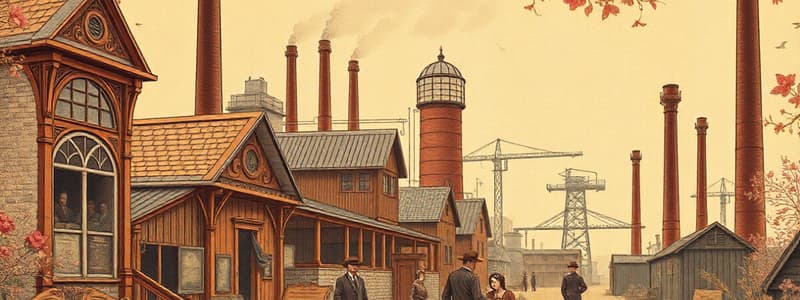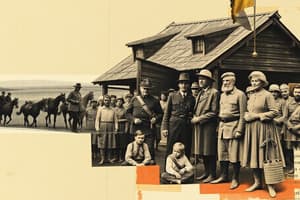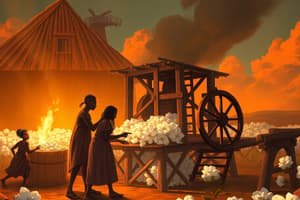Podcast
Questions and Answers
What decision made in 1857 contributed to the division between pro-slavery and anti-slavery factions?
What decision made in 1857 contributed to the division between pro-slavery and anti-slavery factions?
- The Missouri Compromise
- The Emancipation Proclamation
- The Compromise of 1850
- The Dred Scott decision (correct)
Which event was perceived differently by opposing sides, leading to further radicalization in their views?
Which event was perceived differently by opposing sides, leading to further radicalization in their views?
- The signing of the Treaty of Guadalupe Hidalgo
- The election of Abraham Lincoln
- John Brown's raid on Harpers Ferry (correct)
- The attack on Fort Sumter
What was a direct consequence of Abraham Lincoln's election in 1860?
What was a direct consequence of Abraham Lincoln's election in 1860?
- The creation of the Confederacy
- The secession of Southern states (correct)
- The abolition of slavery in all states
- The establishment of a new political party
What underlying issues fueled the Civil War beyond the question of slavery?
What underlying issues fueled the Civil War beyond the question of slavery?
What economic system characterized the Northern states during the period leading up to the Civil War?
What economic system characterized the Northern states during the period leading up to the Civil War?
Which of the following was a significant factor in the Southern economy?
Which of the following was a significant factor in the Southern economy?
How did tariffs affect the economic relationship between the North and the South?
How did tariffs affect the economic relationship between the North and the South?
What was a major consequence of the debates over slavery in new territories?
What was a major consequence of the debates over slavery in new territories?
Which legislative attempts aimed at resolving slavery issues ultimately failed to maintain peace?
Which legislative attempts aimed at resolving slavery issues ultimately failed to maintain peace?
How did different interpretations of the Constitution contribute to the Civil War?
How did different interpretations of the Constitution contribute to the Civil War?
What major political conflict arose from the admission of new states to the Union?
What major political conflict arose from the admission of new states to the Union?
Which of the following statements best describes sectionalism during the period leading up to the Civil War?
Which of the following statements best describes sectionalism during the period leading up to the Civil War?
Flashcards
Dred Scott decision
Dred Scott decision
Supreme Court ruling that enslaved people were not citizens and couldn't sue in federal court.
John Brown's raid
John Brown's raid
Attempt to start a slave rebellion at Harpers Ferry, viewed differently by opposing sides.
Lincoln's election
Lincoln's election
Election of Abraham Lincoln, opposed to slavery expansion, prompted Southern secession.
Southern secession
Southern secession
Signup and view all the flashcards
Fort Sumter attack
Fort Sumter attack
Signup and view all the flashcards
Northern Economy
Northern Economy
Signup and view all the flashcards
Southern Economy
Southern Economy
Signup and view all the flashcards
Economic Disagreements
Economic Disagreements
Signup and view all the flashcards
Slavery's Impact
Slavery's Impact
Signup and view all the flashcards
States' Rights
States' Rights
Signup and view all the flashcards
Sectionalism
Sectionalism
Signup and view all the flashcards
Compromise Failures
Compromise Failures
Signup and view all the flashcards
Balance of Power
Balance of Power
Signup and view all the flashcards
Study Notes
Economic Differences
- The North developed a primarily industrial economy, reliant on factories, manufacturing, and trade. This fostered a strong emphasis on wage labor and a growing urban population.
- The South, conversely, maintained a largely agrarian economy centered on cash crops, particularly cotton. Its economy was deeply interwoven with enslaved labor.
- These contrasting economic systems generated fundamental disagreements regarding tariffs, infrastructure development, and the expansion of industry. The North often favored tariffs to protect their industries from foreign competition, while the South opposed them as they hurt their export trade.
Slavery's Role
- The institution of slavery became a defining feature of the Southern economy and social structure. It was deeply intertwined with the region's agricultural practices and political power.
- The issue of slavery's expansion into new territories ignited intense debate and conflict. The question of whether new states would be free or slave states dramatically fueled tensions between the North and South.
- Abolitionist movements in the North, advocating for the immediate end of slavery, further inflamed the sectional divide. These movements often clashed with the Southern desire to preserve the institution.
- The Missouri Compromise, Compromise of 1850, and Kansas-Nebraska Act, attempts at resolving the slavery question, ultimately failed to achieve lasting peace and only exacerbated tensions. Each attempt at compromise further strained the delicate balance between slave and free states.
Political Disagreements
- Different interpretations of the Constitution led to diverging views about the federal government's power and the rights of individual states. Southerners frequently argued for states' rights and the right of individual states to govern themselves with less federal intervention.
- The balance of power in Congress between free and slave states was a constant source of contention. Every new state admitted to the Union had the potential to upset this delicate balance, creating a cycle of disputes and compromises that only temporarily appeased the underlying tensions.
- Sectionalism grew, with politicians increasingly representing the interests of their region over national unity. Party lines were increasingly drawn along sectional lines, further deepening the political division between North and South. Politicians from one side became increasingly unwilling to compromise with the other side.
Key Events
- The Dred Scott decision in 1857, declaring that enslaved people were not citizens and could not sue in federal court, further galvanized anti-slavery forces and increased Southern confidence with regards to slavery.
- John Brown's raid on Harpers Ferry in 1859, in an attempt to incite a slave rebellion, further radicalized both sides. The event was viewed as either a heroic act or a violent crime depending on each viewpoint.
- The election of Abraham Lincoln in 1860, a Republican opposed to the expansion of slavery, was seen as a threat by the South. This ultimately led to the secession of several Southern states.
Secession and Civil War
- The secession of Southern states, beginning with South Carolina in December 1860, marked a clear break from the Union and set the stage for the Civil War.
- The attack on Fort Sumter in April 1861 marked the beginning of open warfare between the United States and the Confederate States of America.
Conclusion
- Underlying the overt political and social issues were fundamental differences in economic systems, social structures, and views of governance itself. The conflict ultimately proved to be far more than just a question of slavery and resulted in millions of casualties and devastating losses across both countries.
Studying That Suits You
Use AI to generate personalized quizzes and flashcards to suit your learning preferences.




